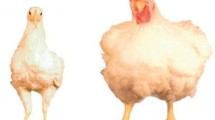Abstract
Thirty-two Polwarth ewes, of ages up to 1 year, were observed in a climatic chamber (24 to 45° C) for eight periods of 5 h each. The observations were made through a window in the chamber wall. All animals were observed four times, then shorn and observed four times again. The animals were given weighed quantities of water and feed consisting of commercial concentrate plus Rhodes grass (Chloris gayana) hay. The water and feed remaining after 5 h of observation were weighed. The following traits were analysed: time eating hay (TEH), time eating concentrate (TEC), time drinking water (TDW), weight of hay eaten (WHE), weight of concentrate eaten (WCE), volume of ingested water (VIW), ruminating time standing up (RTS), ruminating time lying down (RTL), idling time standing up (ITS), and idling time lying down (ITL). Shearing had a significant effect for all traits except ITS. Shearing resulted in higher values for all traits except for ITS and ITL. Ingestion of hay (TEH and WHE) decreased with increased air temperature and humidity, while the ingestion of concentrate (TEC) and WHE) and water (TDW and VIW) increased. Rumination decreased with increased air temperature and humidity, and was higher in shorn than in unshorn sheep.
Similar content being viewed by others
References
Arnold GW, Dudzinski ML (1978) Ethology of free ranging domestic animals. Elsevier, Amsterdam
Baile CA, Forbes JM (1974) Control of feed intake and regulation of energy balance in ruminants. Physiol Rev 54:160
Bhattacharya A, Hussain P (1974) Intake and utilization of nutrients in sheep fed different levels of roughage under heat stress. J Anim Sci 38:877
Bhattacharya A, Uwayjan M (1975) Effect of high ambient temperature and low humidity on nutrient utilisation and some physiological responses in Awasi sheep fed different levels of roughage. J Anim Sci 40:320
Christopherson RJ (1985) The thermal environment and the ruminant digestive system, In: Yousef MK (ed.) Stress physiology in livestock. vol I. CRC Press, Boca Raton, Fla
Conrad JH (1985) Feeding farm animals in hot and cold environments. In: Yousef MK (ed) Stress physiology in livestock, vol II. CRC Press, Boca Raton, Fla
Fares MA, Paranhos da Costa MJR, Morào F, Nogueira OR (1987) Alguns aspectos do comportamento de ovinos lanados e deslanados em rebanhos mistos e separados. In: Paranhos da Costa MJR, Nascimento Jr AF (eds) Encontro anual de etologia, 5. FUNEP, Jaboticabal, p 310
Forbes JM (1986) The voluntary food intake of farm animals. Butterworths, London
Harvey WR (1960) Least squares analysis of data with unequal subclass numbers. ARS-USDA, Publ. nr 20-28, Beltsville
Kennedy PM, Christopherson RJ, Milligan LP (1982) Effect of cold exposure on feed protein degradation, microbial protein synthesis and transfer of plasma urea to the rumen of sheep. Br J Nutr 47:523
Klemm GH (1962) The reactions of unshorn and shorn sheep to hot wet and hot dry atmosphere. Aust J Agric Res 13:472
Martin P, Bateson P (1986) Measuring behaviour an introductory guide. Cambridge University Press, Cambridge
Mendes MA, Leäo MI, Silva JFC, Silva MA, Campos OF (1976) Efeito da temperatura ambiente e do nivel de energia da racão sobre os consumos de alimentos e de água e algumas variáveis fisiológicas de ovinos. Rev Soc Bras Zoot 5(2):173
NRC (1981) Effect of environment on nutrient requirement of domestic animals. National Academy Press, Washington, DC
Thwaites CJ (1985) Physiological responses and productivity in sheep. In: Yousef MK (ed) Stress physiology in livestock, vol II. CRC Press, Boca Raton, Fla
Welch JG, Palmer RH, Gilman EE (1982) Mastication by cattle in cold or neutral environments. Abstracts Annual Meeting American Society Animal Science/Canadian Society Animal Science, Lincoln, Nebraska. American Society of Animal Science, p 474
Weston RH (1977) Metabolic state and roughage consumption in sheep. Proc Nutr Soc Aust 2:88
Author information
Authors and Affiliations
Rights and permissions
About this article
Cite this article
Paranhos da Costa, M.J.R., da Silva, R.G. & de Souza, R.C. Effect of air temperature and humidity on ingestive behaviour of sheep. Int J Biometeorol 36, 218–222 (1992). https://doi.org/10.1007/BF02726401
Received:
Revised:
Accepted:
Published:
Issue Date:
DOI: https://doi.org/10.1007/BF02726401



